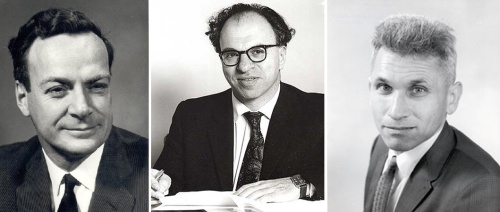by Shane L. Larson
In a 2012 article in Esquire, the inimitable American magician Teller noted, “Sometimes magic is just someone spending more time on something than anyone else might reasonably expect.”
This past week, the world was greeted with the news that a worldwide collaboration of scientists, in a multiple collaborations, made a magical announcement: they have detected a faint gravitational hum coming from the Cosmos, created by pairs of super-massive black holes, strewn across the Universe, dancing around each other in slow, languorous orbits that shed gravitational waves.
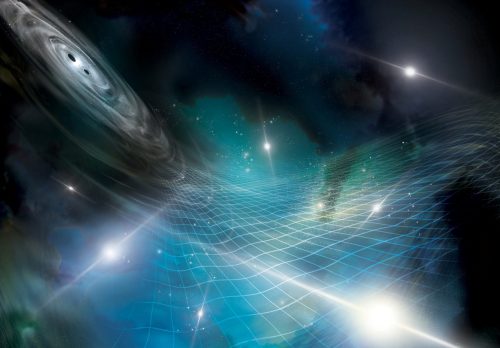
An artistic interpretation of an array of pulsars immersed in gravitational waves from a distant supermassive black hole binary. [Image: Aurore Simonnet/NANOGrav Collaboration]
Let me tell you three things about this remarkable achievement.
[1] What is a “nanohertz gravitational wave background”?
This tale begins with the idea that nothing in the Universe has to only be found leading solitary monastic lives, drifting along in the vast void. Very often, objects can find each other (or are born together) through their mutual gravitational attraction — this includes, stars, planets, asteroids, galaxies, and as it turns out, black holes.
We know from long, detailed studies of the sky with telescopes two remarkable things.
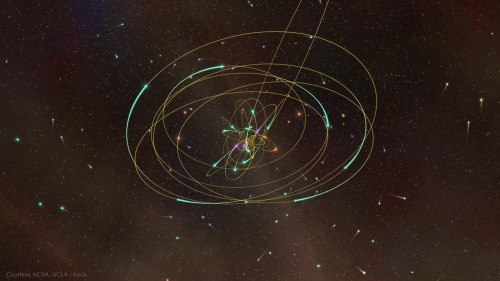
Two decades of observations have shown the orbits of stars around the supermassive black hole at the center of the Milky Way. Observations like these earned Andrea Ghez and Reinhard Genzel their share of the 2020 Nobel Prize in Physics. [NCSA/UCLA/Keck]
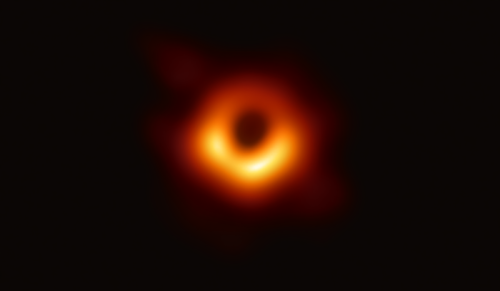
The first picture of the black hole at the heart of M87, formed by light being bent around the inner most regions of space outside the black hole. [Image: Event Horizon Telescope Collaboration]
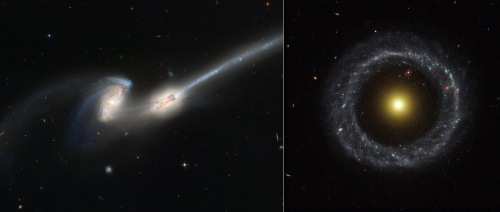
Examples of the consequences of galaxy collisions. (left) A pair of galaxies mid-collision, known as “The Mice”. (right) A ring galaxy known as Hoag’s Object. [Both Images: Hubble/STScI/AURA]
When the black holes do find one another, they dance around in an orbit, not unlike the orbits of the Moon around the Earth. Long before the black holes make their final crash, those orbits are large and can take many decades to complete. During this time, as they warily spiral around one another, they are constantly changing the parts of the Universe they are bending with their gravity, and that change ripples out through the Cosmos as “gravitational-waves.”
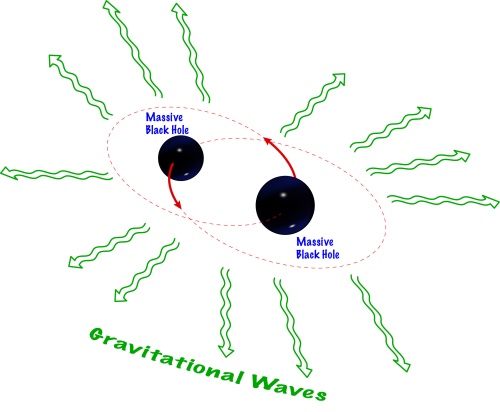
As massive objects orbit one another and get closer and closer together, they emit gravitational waves in all directions. [Image: S. Larson]
Which brings us to the last word, “background.” This is a bit of scientific jargon, but it describes a phenomena that most of us are likely familiar with. Consider the last time you were out shopping, or at a high-school basketball game, or in a crowded restaurant. Immersed in a crowd of hundreds of people all carrying on conversations and laughing, you were immersed in a cacophony of sound. You could certainly hear the person next to you (with whom you were probably discussing the discovery of the nanohertz gravitational-wave background), but all the other conversations are overlapping and blended into the “background.” The gravitational-wave background is the same way — there are so many pairs of massive black holes strewn across the Cosmos, all of them shedding gravitational waves, that the cacophony of them merges to form a faint hum of indistinguishable signals.
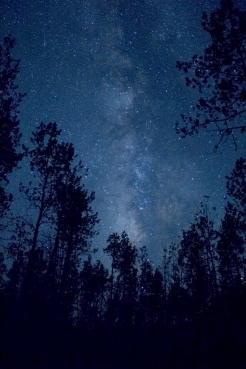
From dark sites far from cities, you can see the Milky Way in the night sky overhead, as in this image over the Pando Forest in Utah. [Image: Shane L. Larson]
[2] How was the nanohertz background detected?
You may have heard of gravitational-wave observatories before (LIGO, and LISA), but this new discovery was made with a remarkable technique known as pulsar timing, where we mesh our own modern technology with natural phenomena from Nature to create a galaxy-spanning gravitational-wave antenna array.
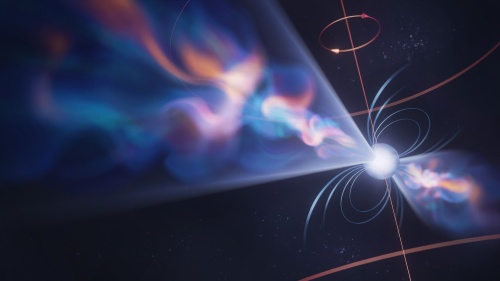
Artist’s rendering of a pulsar – a rapidly rotating neutron star that emits a beam of radio light that passes the Earth once every rotation. This results in a detectable pulse from the star, hence the term pulsar. [Image: Olena Shmahalo/NANOgrav]
Astronomers create pulsar timing arrays (PTAs) by using radio telescopes on Earth to monitor a large collection of pulsars every now and then for decades. Today, there are several such collaborative enterprises on Earth: NANOgrav in North America, the European PTA in Europe, the Indian PTA in India, the Parkes PTA in Australia, and an overarching global collaboration called the International PTA. Each of these collaborations watches their set of pulsars, and records with exquisite precision what time each of the pulses arrives at Earth.
Because each of the pulsars lived their own lives, in their own little corner of the galaxy, we expect there to be nothing about any of the pulsars that is related between them — in the absence of anything going on, each their signals arrive at Earth at a predicted time defined by the pulsar and where it is relative to Earth. Nothing is correlated (in the literal sense of the word) between the pulsar signals.
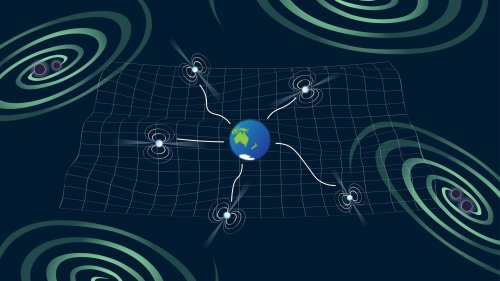
An artist’s impression of a pulsar timing array, immersed in a sea of gravitational waves from supermassive black hole binaries outside the galaxy. [Image: Shanika Galaudage]
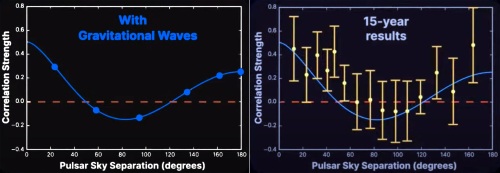
Summary graphs of the results from NANOgrav. The curve shows the correlations between pulsars in the array due to gravitational waves. (left) The red dashed line is how “uncorrelated data” from pulsars looks. The blue curve is the expected relation between pulsars when gravitational-waves pass by, known as a “Hellings-Downs curve.” (right) The same curve, with NANOgrav’s data overlaid. [Image: NANOgrav]
[3] It’s really about people.
Science is often a long game, particularly science that probes the limits of human knowledge, and science done with advanced technology and tools that can’t fit in your pocket or on a laboratory bench. It takes hundreds and thousands of minds to conceive of what is possible, and then unflagging tenacity to solve each of the problems that arises until — in the end — a remarkable discovery is made. That long and arduous process means that people come and go, as they follow their own winding pathways to careers and life. But it also means we lose some people along the way who pass on, returning to the stardust from which we came. Here, I’d like to draw attention to just two of those people.
The first person was Ron Hellings. Ron is the Hellings of the “Hellings-Downs” curve, the swooping pattern of correlated signals from the scattered beacons in the pulsar timing array. He and his collaborator, George Downs, first wrote down what that pattern would look like and what pulsar astronomers should look for in a paper in 1983; it was only this week in 2023, forty years later, that their idea came to fruition.
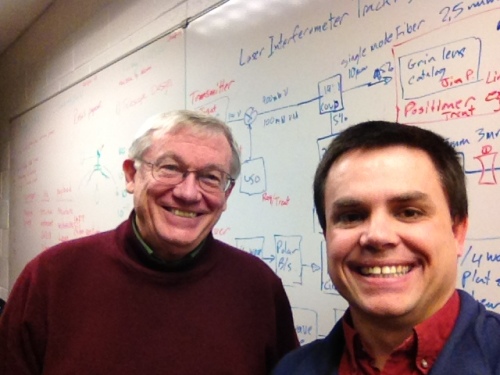
Me and Ron Hellings in 2012, working on the details of a gravitational-wave observatory. [Image: S. Larson]
I have the good fortune of being one of Ron’s academic descendants. I first met him when I was working on my PhD thesis, where we were thinking about the LISA gravitational-wave observatory. It was the beginning of a collaborative enterprise and a friendship that spanned a quarter of a century. We worked on many things together, including LISA, how to think about gravitational-wave signals, how to teach students, and a zillion other things in physics and astronomy. After I finished my PhD I spent two years as his postdoc, when he was at the Jet Propulsion Laboratory. It was an exhilarating and exciting time, and firmly set me on the path of my career today.
The second person was Steve Detweiler. By the time I was in graduate school, in the late 1990s, Steve was already famous in our community. Like most of those famous people, he was larger than life to us students, but he was always friendly. At meetings, he talked with us at coffee breaks, came to our talks, and sometimes went to dinner with us. I knew Steve for many years after we first met, and we would talk at conferences and meetings where our work on gravitational-waves overlapped.
Steve was well known for many things in his career, but in the late 1970s he was the first person to propose that pulsar timing could be used to search for gravitational-wave backgrounds; in no uncertain terms, his original analysis sent us down pathway to the discovery that was announced this week.Steve sadly passed away on 8 February 2016, just three days before the first announcement of the discovery of gravitational waves, and seven years before this week’s announcement of the confirmation of his idea for how to sense the Cosmos anew.
For me, Steve was more than a scientific acquaintance. There came a time when I had to prepare my dossier for tenure as a University professor. The process involves a robust independent evaluation of a person’s contribution to the scientific enterprise. For part of it, the University asks several experts from around the world to make a blunt assessment about the tenure dossier. I got to pick two people, and the University picked four; needless to say it is a terrifying prospect, especially for those of us who don’t have the global stature many of our colleagues have in the field. But I asked Steve to write one of my assessments, and he agreed. I have no idea what he said (his letter was confidential), but whatever it was, the University tenured me, and I owe Steve a great thanks.
My stories and relationships with these senior scientists in the field are not unique — all of us have been encouraged, mentored, and brought into the great adventure of science by colleagues like Ron and Steve. At the NANOgrav press conference, our colleague Maura McLaughlin pointed out that the NANOgrav collaboration involved hundreds of graduate students, undergraduates, and even high school students. Every one of these contributed their time, their unique enthusiasm and energy, and their skills to making the discovery happen.
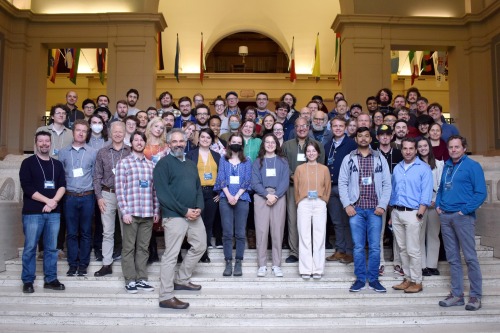
Not everyone, but some of the members of the NANOgrav collaboration at a recent meeting. People make science happen. [Image: NANOgrav]
In the end, it’s all about people, and that is the true legacy — the true magic — of the wondrous discovery of the nanohertz gravitational-wave background.
My heartfelt congratulations, respect, and admiration goes out to all my friends and colleagues who made this discovery possible. Excelsior!











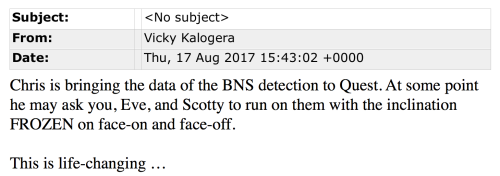
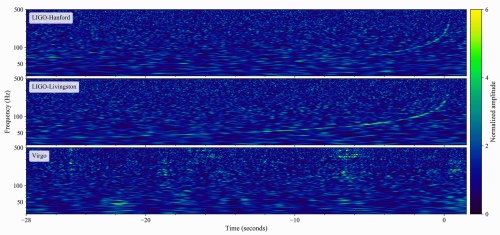

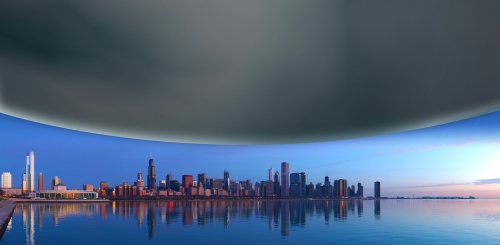


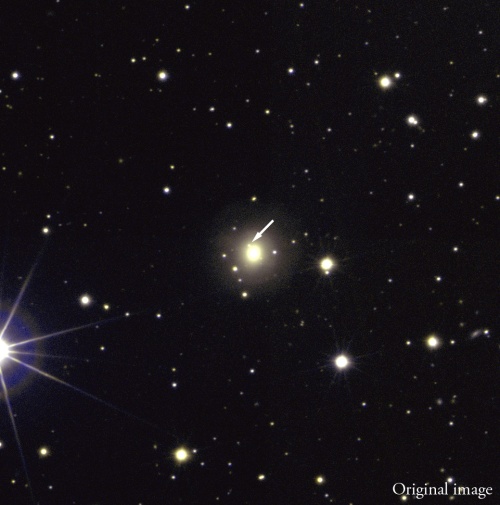

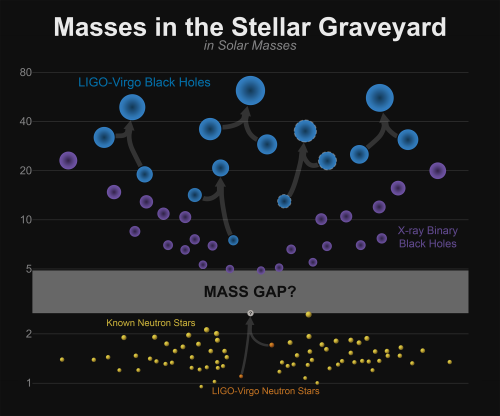
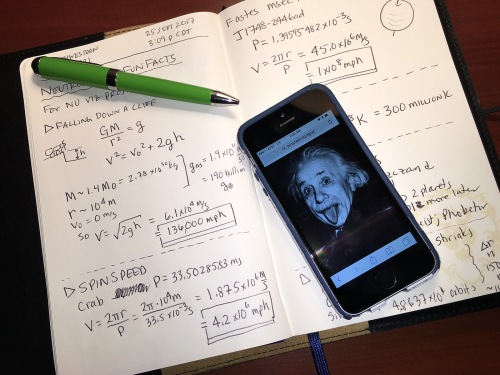
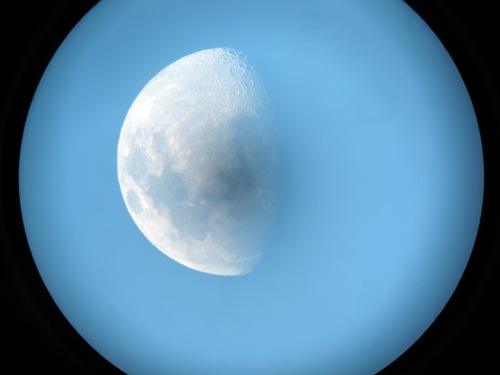
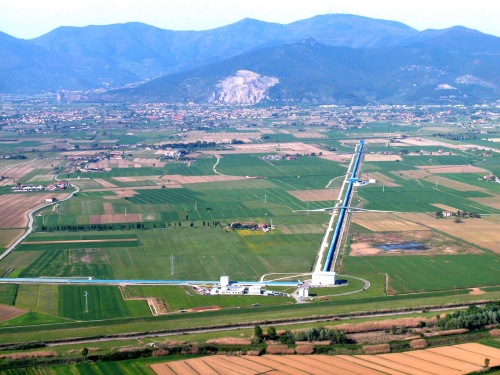
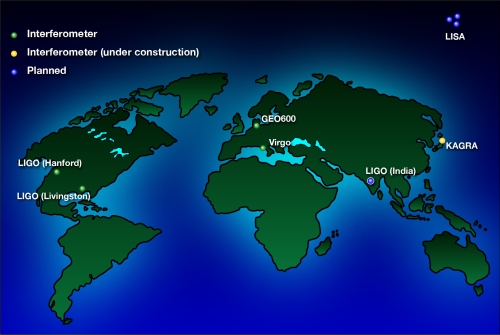
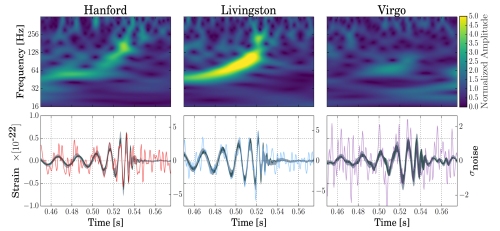
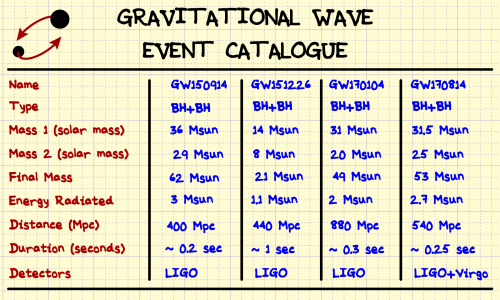
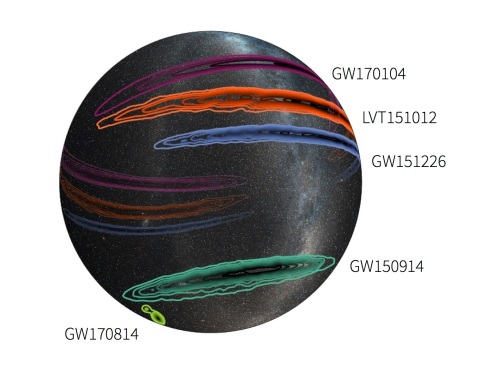











![The night sky over the Pando Forest in central Utah. Pando is an 80,000 year old aspen grove -- it has seen almost 30 million nights like this one, but very little has changed. The constellations change over thousands of years, but the sky is still full of stars, and the Milky Way still arches over the sky, giving the impression that the Universe is unchanging. [Image: Shane L. Larson]](https://writescience.files.wordpress.com/2015/03/pandoforest.jpg?w=254&h=381)


![Visualization of LIGO interferometry. (A) When no gravitational wave is present, the laser timing is set up to make a "dark fringe" at the output [square panel on the right]. (B) At the output, the light is like waves canceling each other out. (C) When a wave stretches or compresses the arms, it changes how the light is added together at the output. [Frames from video by Caltech/LIGO]](https://writescience.files.wordpress.com/2016/02/ligo_interferometerframes22.jpg?w=500&h=835)



![Picking crab with Tyson (far right) and family. [Image: Sabrina Savage]](https://writescience.files.wordpress.com/2016/02/crabpicking02.jpg?w=500&h=236)
![Frame from a visualization of the binary black hole merger seen by LIGO [Visualization by "Simulating Extreme Spacetime" (SXS) Collaboratoin]](https://writescience.files.wordpress.com/2016/02/sxs_gw150914.jpg?w=500&h=281)
![(L) Aerial view of LIGO-Hanford Observatory [top] and in Google Maps [Bottom]. (R) Aerial view of LIGO-Livingston Observatory [top] and in Google Maps [Bottom].](https://writescience.files.wordpress.com/2014/04/ligogridimages.jpg?w=500&h=410)
![Schematic of the LIGO interferometers, showing the basic layout of the lasers and optics locations. [Image: S. Larson & LIGO Collaboration]](https://writescience.files.wordpress.com/2016/02/sll_interferometercutaway_v2.jpg?w=500&h=448)
![Spectrograms of the event at Hanford and Livingston. The darker areas are what a "typical" spectrogram might look like; the bright swoops are the (very noticeable) signal! [Image: LIGO Collaboration]](https://writescience.files.wordpress.com/2016/02/fig1_split_v17_bottom_standalone.jpg?w=500&h=157)
![My journal page from the hour after I first found out about the event. [Image: S. Larson]](https://writescience.files.wordpress.com/2016/02/journaltrimmed_sm.jpg?w=500&h=398)
![A more technical simulation of the binary black hole merger; gravitational physicsists and astronomers will be comparing the data to their simulations to examine how well we understand "real" black holes. [Image: SXS Collaboration]](https://writescience.files.wordpress.com/2016/02/kipharald_gw150914.jpg?w=500&h=281)
![Just some of the thousands of people who have made LIGO a reality and the detection of GW150914 possible. [Images from the LIGO Collaboration]](https://writescience.files.wordpress.com/2016/02/ligopeople.jpg?w=500&h=519)


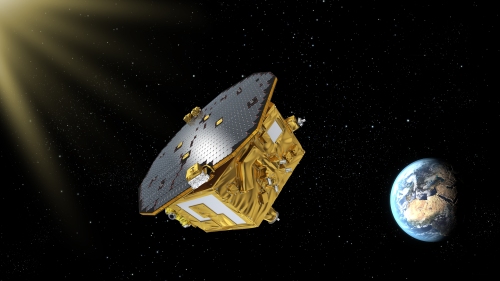



 The scientists and engineers who contemplate these things every day are ingenious and clever. The delivery of LISA Pathfinder was the culmination of a decade long effort by an enormous team of scientists and engineers. And all the while they were designing and building LISA Pathfinder, they were teaching classes, and training new students and young scientists who will go on to do new and awesome things in the future. These are the people who make our modern world go ’round. I have nothing but admiration for my colleagues who have built and flown this marvelous machine.
The scientists and engineers who contemplate these things every day are ingenious and clever. The delivery of LISA Pathfinder was the culmination of a decade long effort by an enormous team of scientists and engineers. And all the while they were designing and building LISA Pathfinder, they were teaching classes, and training new students and young scientists who will go on to do new and awesome things in the future. These are the people who make our modern world go ’round. I have nothing but admiration for my colleagues who have built and flown this marvelous machine.



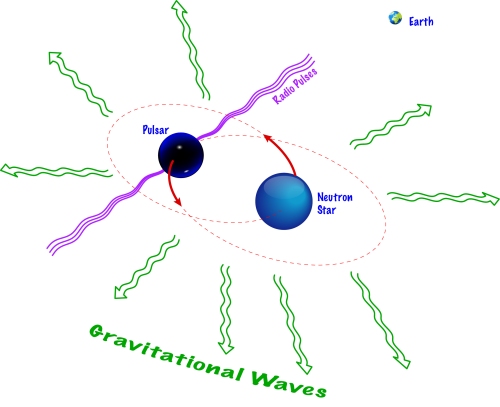



![The night sky over the Pando Forest in central Utah. Pando is an 80,000 year old aspen grove -- it has seen almost 30 million nights like this one, but very little has changed. The constellations change over thousands of years, but the sky is still full of stars, and the Milky Way still arches over the sky, giving the impression that the Universe is unchanging. [Image: Shane L. Larson]](https://writescience.files.wordpress.com/2015/03/pandoforest.jpg?w=260&h=390)

![Examples of colliding galaxies. (T) NGC 4676 [the Mice], and (B) NGC 6621](https://writescience.files.wordpress.com/2015/05/collidinggalaxies_n4676_n6621.jpg?w=500&h=491)







